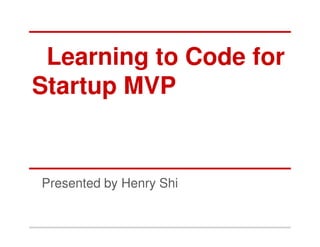Code for Startup MVP (Ruby on Rails) Session 1
- 1. Learning to Code for Startup MVP Presented by Henry Shi
- 2. Agenda ¨C Wednesday November 7 1. Review of Last Session 2. Ruby Basics o Syntax and semantics o Practice makes perfect 1. Rails Models (but no Bottles) o ORM and SQL introduction o Migrations o Making the User model o Signup/Signin/Signout
- 3. Prework ¨C Setup ? Windows (not recommended if possible): o http://railsinstaller.org/ o Use Sublime Text for your text editor ? OSX: o http://railsinstaller.org/ o This includes osx-gcc-installer (200mb) ? Linux: o http://blog.sudobits.com/2012/05/02/how-to-install- ruby-on-rails-in-ubuntu-12-04-lts/
- 4. Prework - Git Install git if not already included: http://www.git-scm.com/book/en/Getting- Started-Installing-Git Configure Git: git config --global user.name "Your Name¡° git config --global user.email your.email@example.com
- 5. Review of Last Session 1. The Web and How it Works 2. Git/Github 3. Rails and Ruby 4. Heroku
- 6. The Web - Overview
- 7. GIT/GITHUB ? What is GIT? ? Distributed Version Control System (DVCS) ? Why should I care? o Never lose data or accidentally overwrite, delete files o Collaborate with peers anywhere and stay in sync automatically (no more _v1, _v2, _final, _final_final¡) o Compare and track changes over time, and easily revert changes o Deploy code to real web
- 8. Rails ? Ruby on Rails is an open-source web framework that¡¯s optimized for programmer happiness and sustainable productivity. ? It lets you write beautiful code by favoring convention over configuration. ? 80/20 Rule =>great for Startup MVP
- 9. Heroku What is Heroku? ?a hosted platform built specifically for deploying Rails and other web applications in 1 command ?Best thing since sliced bread
- 10. Ruby ¨C Programmer¡¯s Best Friend ? Ruby is a dynamic, open source programming language with a focus on simplicity and productivity. It has an elegant syntax that is natural to read and easy to write. ? We will only cover the necessary syntax needed to create a rails app ? Thankfully, its not a lot ?
- 11. Interactive Ruby Shell ? For the following slides, you should follow along with the Interactive Ruby Shell (irb) ? Open a terminal, type irb and press enter
- 12. Ruby - Strings ? Characters (letters, digits, punctuation) surrounded by quotes food = "chunky bacon" puts "I'm hungry for, #{food}!" >> "I'm hungry for, chunky bacon!" ? Can perform operations on strings, concatenation, length, empty, etc ¡°Hello¡± + ¡°World¡± >> ¡°Hello World" ¡°Henry¡±.empty? >> false
- 13. Ruby - Numbers ? Self Explanatory 123.class (123.0).class >> Fixnum >> Float ? Can add different types of numbers directly
- 14. Ruby - Symbols ? Characters (letters, digits, punctuation) preceded by colon (:) food = :hello :asf3fasdf.class >> Symbol ? Lightweight strings ? immutable
- 15. Ruby - Array ? List surrounded by square brace and separated by commas, zero indexed a = [1, 2, 3] b = ('a'..'e').to_a # ["a", "b", "c", "d", "e"] c = %w[foo bar baz quux] # ["foo", "bar", "baz", "quux"] ? Can perform operations on arrays, add, remove, reverse etc
- 16. ERROR: undefined OFFENDING COMMAND: f¡®~ STACK:














![Ruby - Array
? List surrounded by square brace and
separated by commas, zero indexed
a = [1, 2, 3]
b = ('a'..'e').to_a # ["a", "b", "c", "d", "e"]
c = %w[foo bar baz quux] # ["foo", "bar", "baz", "quux"]
? Can perform operations on arrays, add,
remove, reverse etc](https://image.slidesharecdn.com/learningtocodeforstartupmvpsession2-121107202559-phpapp01/85/Code-for-Startup-MVP-Ruby-on-Rails-Session-1-15-320.jpg)
